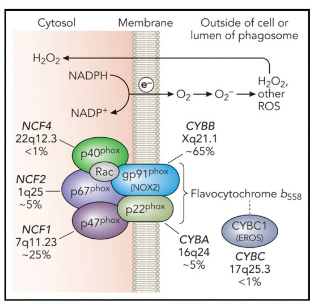You are about to go to a website sponsored by Amgen. Would you like to continue?
You will be going to an external website operated by an independent third party. Your activities at the external website will be managed by their policies and practices. By clicking “Continue,” you will go to the external website.

CGD is a disorder that affects neutrophil function in NADPH oxidase, which is made up of multiple subunits and produces reactive oxygen species (ROS) used to kill pathogens.1,2
Mutations in any one of the 6 genes that make up the various parts of NADPH oxidase can reduce the neutrophils’ ability to produce ROS. This failure results in CGD, due to the inability of neutrophils to kill certain bacteria and fungi.1,2


*Highly skewed X-inactivation from an inherited CYBB variant, highly skewed X-inactivation from a de novo mutation, and somatic mosaicism for a CYBB pathogenic variant.
1. Leiding JW, Holland SM. Chronic granulomatous disease. In: Pagon RA, Adam MP, Ardinger HH, et al, eds. GeneReviews®. Seattle, WA: University of Washington, Seattle; 1993-2022. 2. Rider NL, Jameson MB, Creech CB. Chronic granulomatous disease: epidemiology, pathophysiology, and genetic basis of disease. J Pediatric Infect Dis Soc. 2018;7(suppl 1):S2-S5. 3. Kuhns DB, Alvord WG, Heller T, et al. Residual NADPH oxidase and survival in chronic granulomatous disease. N Engl J Med. 2010;363(27):2600-2610. 4. Thomsen IP, Smith MA, Holland SM, Creech CB. A comprehensive approach to the management of children and adults with chronic granulomatous disease. J Allergy Clin Immunol Pract. 2016;4(6):1082-1088. 5. van de Geer A, Nieto-Patlán A, Kuhns DB, et al. Inherited p40phox deficiency differs from classic chronic granulomatous disease. J Clin Invest. 2018;128(9):3957-3975. 6. Dinauer MC. Inflammatory consequences of inherited disorders affecting neutrophil function. Blood. 2019;133(20):2130-2139.